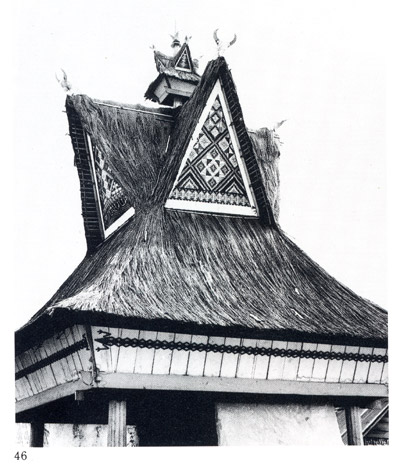
Figure 46, (page 41)
Pages 40, 41
Elaborate matting skills probably existed in prehistoric times. Interlacing (or plaiting) usually requires only a simple instrument to strip the fibre (46, 47) and, as with textiles and the wooden apparatus used to make them, no ancient mats have survived thousands of years of hot, wet, tropical conditions. We are left with imprints on prehistoric pot-tery which was beaten with basketry or corded paddles. Matting and forms of twining, however, may have been the forerunners of more recent textile traditions, and like bark-cloth fabric, are still the basis for textile seats, mats, bags and some types of tunics decorated with shells and beads.

Figure 46, (page 41)
This rice barn in the Karo Batak region of north Sumatra is decorated with motifs similar to those found on textiles. The plaited bamboo under the roof forms geometric patterns while a long lizard shape is depicted along each side of the lower wall.
Pages 70-72
The strength of narrow banded patterns is evident in the simple (figs 96,98) lines of two-colour warp ikat woven by many ethnic groups, such as the Batak peoples of north Sumatra, who have remained comparatively isolated from external influence and trade until recent times. However, banded patterns have been retained even in Southeast Asian cultures long exposed to foreign ideas, materials and designs. The Malays of Terengganu, for example, have created silk textiles with weft ikat bands, and both Batak and Malay artisans work with combinations of ancient chevron and rhomb shapes to achieve comparable patterns.
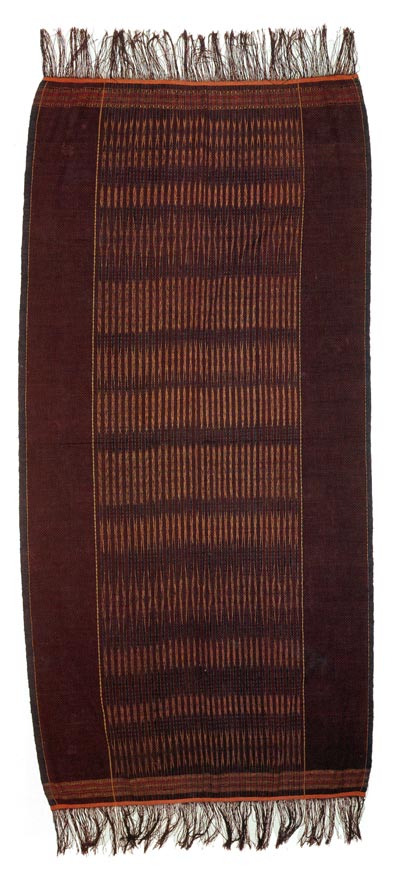
Figure 96 (page 70 )- ulos
rujat
Ceremonial cloth, Toba Batak people, north Sumatra, Indonesia, handspun cotton, natural dyes, warp ikat, supplementary weft weave, twining 93.5 x 219.4 cm Australian National Gallery 1983.3696
Throughout Southeast Asia the simplest warp ikat patterns consist of narrow warp bands of S spirals, V and rhomb motifs. On this wide, single panel cloth associated with the Porsea district of the Toba Batak region of north Sumatra, the central patterning is flanked by red-brown borders woven in threads dyed with Morinda citrifolia roots, known to the Toba Batak as bangkudu. (Another popular cloth made elsewhere in the Toba region, the ulos sibolang, has a similar structure and design although it is woven entirely in shades of indigo from Marsdenia tinctoria, known locally as salaon.) A little supplementary weaving appears across each end and the design of the cloth suggests that in the past it may also have been made in three sections in the manner of some other Toba Batak textiles. The fringe and the twined borders, traditionally the work of men, show precise and detailed patterns that contrast with the soft blurring of the central ikat, and are suggestive of the carving on architectural structures and other objects also executed by men and painted in the same red, black and white colours. Early twentieth century.
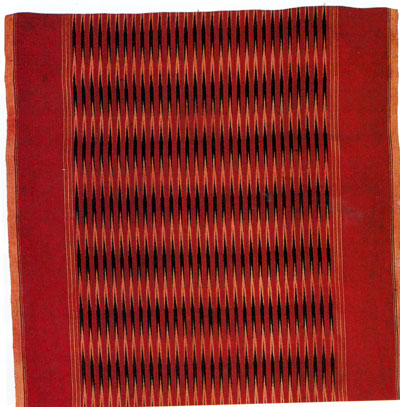
Figure 98 (detail) (page 72) - ija plang rusa; ija plang rutha
Man's waistcloth; wrap, Aceh, Sumatra, Indonesia; used in Kelantan, Malaysia, silk, natural dyes, warp ikat 96.4 x 190.8 cm Australian National Gallery 1985.381
This nineteenth-century man's wrap is an item of ceremonial dress in Kelantan, Malaysia, where men's trousers were also made of the same fabric. However, other Kelantan ikat silk fabrics are decorated with weft patterns and there is no clear evidence that the arrowhead warp ikats sometimes attributed to Kelantan were actually woven there. This particular textile was almost certainly woven in Aceh, north Sumatra. Despite its proximity to India and its position on the old trade routes, Aceh was one of the very few areas in Southeast Asia to continue to use the warp ikat technique after silk thread was introduced. Weft ikat was never practised in Aceh, although according to early travellers' records, silk thread was widely used there and was eventually produced locally. This cloth is deep red with narrow stripes of black and white ikat. Cotton textiles of (Fig 98) almost identical size, colour and design are woven in the nearby Toba Batak region of north Sumatra where they are used as ceremonial baby-carriers (ulos mangiring).
Pages 119, 121
(171,174) Among the various Batak peoples of north Sumatra, there are a (175) number of important ceremonial textiles that have male and female ends where each set of gender-related elements is concentrated. These include Toba Batak cloths (such as the ulos ragidup and the ulos pinunsaan), the Simalungun Batak headcloth, and some nineteenth-century Mandailing and Angkola Batak textiles. The most northerly weaving districts of the neighbouring Minangkabau people also appear to have integrated comparable pairs of schematic shapes into a striking band at each end of certain cloths. Further south in the Bengkulu and Pasemah region of Sumatra, the arrangement of different designs and the structure of the pattern at each end of the shouldercloth suggest an interesting comparison with the overt and intentional sexual imagery of Batak textiles.
While Batak elders readily identify the male and female ends and the sexual images on their textiles, such explicit identification of sexual symbolism is no longer apparent in neighbouring Sumatran areas. Minangkabau weavers understand the lozenge motifs on their supplementary silk textiles to be ceremonial cakes or heaps of sirih (an ingredient for betel-nut chewing), and triangular shapes are believed to represent bamboo shoots or 'the tree of life' (Sanday and Kartiwa, 1984: 18-25). While these motifs are now reduced to geometric patterning, and are identified with familiar everyday objects from the world around them, the weavers' ancestors may have intended motifs such as these to represent human figures.
Certain textiles are specifically
designed to communicate with spirits. When physical danger threatens, such as
an unexplained illness or pregnancy, a shaman or seer may prescribe the weaving
of a special cloth to protect the owner and dispel the evil. A Batak village
priest might suggest the weaving of an ulos ragidup as a cure for personal
difficulties. This striking cloth, woven by a complex series of procedures,
was also used in the past as an aid to divination. Textiles are also used by
shamans among the peoples of northern Luzon, where they appear in a variety
of ceremonies designed to placate the spirits. But instead of being read to
predict the future, in this part of Southeast Asia they appear to hold the key
to past events, such as the performance of great ceremonies (Ellis, 1981: 224-30).
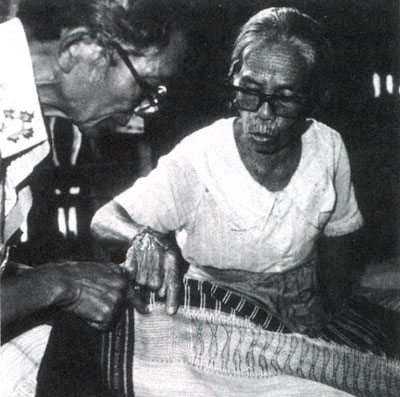
Fig 171
Two Toba Batak elders discuss the meaning of the motifs on the man's ulos
ni tondi (soul-cloth), a finely worked ulos ragidup ('design of
life') from the Taratung district south of Lake Toba. The ulos ragidup
and ulos pinunsaan can be read by experts as an oracle to predict the
future and particular cloths or designs might be prescribed by a Batak shaman
as a cure for misfortune (Gittinger, 1975: 13-15).
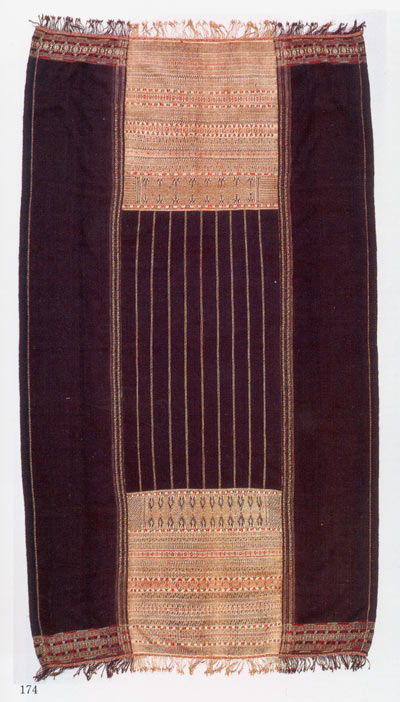
Fig 174 ulos pinunsaan
Ritual cloth for clothing, wrapping and shroud, Toba Batak people, Porsea district,
north Sumatra, Indonesia, cotton, natural dyes, supplementary warp weave, supplementary
weft weave, warp ikat, twining 125.0 x 225.0 cm Australian National Gallery
1984.256

Fig 175 - bulang
Woman's headcloth, Simalungun Batak people, north Sumatra, Indonesia, handspun
cotton, natural dyes supplementary weft weave, supplementary warp weave 187.0
x 35.0 cm Australian National Gallery 1984.1247
On certain Toba Batak ritual textiles (ulos), such as the ulos ragidup and the seemingly identical ulos pinunsaan, (also known as pinussaan and nipussaan after the term sometimes used for the white inset panels, pussa), the widest band of supplementary weft patterns (pina halak) at each end are distinctly though schematically male and female. The male pin a halak band is composed of elongated triangular shapes (baoa) while the dominant female motif in the other pina halak band is the rhomb (boru-boru). (The terms tulang baoa and boru are also used to refer to key elements in the Toba Batak kinship system.) When using the cloths to cover the dead or to envelop the living, Toba Bataks are careful to extend the end appropriate to the gender of the recipient.
A complicated and ordered sequence of weaving the intricate, supplementary weft ends containing these male and female motifs, in the sacred tricolour of black, white and red, is strictly observed - even by younger weavers who are uncertain or ignorant of the sexual references of these ancient motifs. In the Porsea district on the eastern shores of Lake Toba, the three central sections of the ulos pinunsaan are woven separately, cut and then sewn together with the side panels to form a completed cloth. The ulos ragidup that are woven by the Toba Batak peoples south of the lake and the brick-red woman's headcloth (bulang) from the Simalungun Batak (sometimes also referred to as the Eastern Batak or Batak Timur) have an elaborately woven central section. The two end panels are not woven separately but are worked on a second, white warp which is inserted during the weaving process (Gittinger, 1975: 13-15). This difficult and lengthy procedure can only be understood through an awareness of the supernatural powers that these traditional cloths are thought to possess and the notion of an unbroken, circulating warp as a metaphor linking male and female realms. Both cloths probably date from the early twentieth century.
Pages 365, 366
With the increase in Western education
in Southeast Asia from the end of the nineteenth century, messages and personal
signatures in Romanized lettering began to appear on many textiles. In particu¬lar,
the practice of signing garments became popular among weavers in the Christian
areas of Indonesia where initials or even full names appear in warp ikat. Where
textiles are intended to convey a message or greeting, this is sometimes spelt
out on the cloth. The most popular message in the Malay peninsula and the Indonesian
archipelago conveys good wishes for the use or wearing of the cloth (selamat
pakai), while many Batak ceremonial ulos gifts are now emblazoned
with the greeting Horas Mahita or a detailed embroidered account of
the occasion and the names of the leading participants.